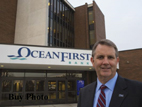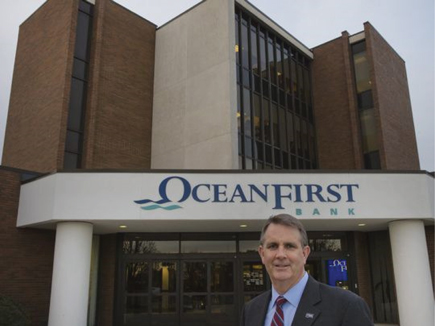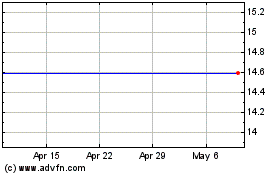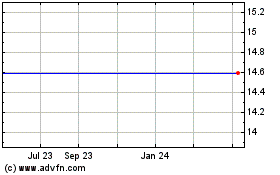FILED BY OCEANFIRST FINANCIAL CORP.
PURSUANT TO RULE 425 UNDER THE SECURITIES ACT OF 1933
AND DEEMED FILED PURSUANT TO RULE 14a-12
UNDER THE SECURITIES EXCHANGE ACT OF 1934
SUBJECT COMPANY: CAPE BANCORP, INC.
COMMISSION FILE NO. 001-33934
On
January 29, 2016, an article featuring an interview with Christopher D. Maher, President and Chief Executive Officer of OceanFirst Financial Corp. (“OceanFirst”), was posted to the website www.app.com. A copy of such article is
set forth herein. The original article can be found at the following web address: http://www.app.com/story/money/business/2016/01/29/oceanfirst-bank/79402960/.
Forward-Looking Statements
This report contains
forward-looking statements. These forward-looking statements may include: management plans relating to the Transaction; the expected timing of the completion of the Transaction; the ability to complete the Transaction; the ability to obtain any
required regulatory, shareholder or other approvals; any statements of the plans and objectives of management for future operations, products or services, including the execution of integration plans; any statements of expectation or belief;
projections related to certain financial metrics; and any statements of assumptions underlying any of the foregoing. Forward-looking statements are typically identified by words such as “believe,” “expect,”
“anticipate,” “intend,” “outlook,” “estimate,” “forecast,” “project” and other similar words and expressions. Forward-looking statements are subject to numerous assumptions, risks and
uncertainties, which change over time and are beyond our control. Forward-looking statements speak only as of the date they are made. Neither OceanFirst nor Cape Bancorp, Inc. (“Cape”) assumes any duty and does not undertake to
update forward-looking statements. Because forward-looking statements are subject to assumptions and uncertainties, actual results or future events could differ, possibly materially, from those that OceanFirst or Cape anticipated in its
forward-looking statements and future results could differ materially from historical performance. Factors that could cause or contribute to such differences include, but are not limited to, those included under Item 1A “Risk Factors”
in OceanFirst’s Annual Report on Form 10-K, those included under Item 1A “Risk Factors” in Cape’s Annual Report on Form 10-K, those disclosed in OceanFirst’s and Cape’s respective other periodic reports filed with
the Securities and Exchange Commission (the “SEC”), as well as the possibility: that expected benefits may not materialize in the timeframe expected or at all, or may be more costly to achieve; that the Transaction may not be timely
completed, if at all; that prior to the completion of the Transaction or thereafter, OceanFirst’s and Cape’s respective businesses may not perform as expected due to transaction-related uncertainty or other factors; that the parties are
unable to successfully implement integration strategies; that required regulatory, shareholder or other approvals are not obtained or other customary closing conditions are not satisfied in a timely manner or at all; reputational risks and the
reaction of the companies’ customers, employees and other constituents to the Transaction; and diversion of management time on merger-related matters. For any forward-looking statements made in this report or in any documents, OceanFirst and
Cape claim the protection of the safe harbor for forward-looking statements contained in the Private Securities Litigation Reform Act of 1995.
Annualized, pro forma, projected and estimated numbers are used for illustrative purposes only, are not forecasts and may not reflect actual results.
Additional Information about the Transaction
This
communication is being made in respect of the proposed Transaction involving OceanFirst and Cape. This material is not a solicitation of any vote or approval of OceanFirst’s or Cape’s shareholders and is not a substitute for the joint
proxy statement/prospectus or any other documents which OceanFirst and Cape may send to their respective shareholders in connection with the proposed Transaction. This communication shall not constitute an offer to sell or the solicitation of an
offer to buy any securities.
In connection with the proposed Transaction, OceanFirst intends to file a registration statement on Form S-4
containing a joint proxy statement/prospectus and other documents regarding the proposed Transaction with the SEC. Before making any voting or investment decision, the respective investors and shareholders of OceanFirst and Cape are urged to
carefully read the entire joint proxy statement/prospectus when it becomes available and any other relevant documents filed by either company with the SEC, as well as any amendments or supplements to those documents, because they will contain
important information about OceanFirst, Cape and the proposed Transaction. Investors and security holders are also urged to carefully review and consider each of OceanFirst’s and Cape’s public filings with the SEC, including but
not limited to their Annual Reports on Form 10-K, their proxy statements, their Current Reports on Form 8-K and their Quarterly Reports on Form 10-Q. When available, copies of the joint proxy
statement/prospectus will be mailed to the respective shareholders of OceanFirst and Cape. When available, copies of the joint proxy statement/prospectus also may be obtained free of charge at the SEC’s web site
at http://www.sec.gov, or by directing a request to OceanFirst Financial Corp., 975 Hooper Avenue, Toms River, New Jersey 08753, Attn: Jill Apito Hewitt, Senior Vice President and Investor Relations Officer.
Participants in the Solicitation
OceanFirst, Cape and
certain of their respective directors and executive officers, under the SEC’s rules, may be deemed to be participants in the solicitation of proxies of OceanFirst’s and Cape’s shareholders in connection with the proposed Transaction.
Information about the directors and executive officers of OceanFirst and their ownership of OceanFirst common stock is set forth in the proxy statement for OceanFirst’s 2015 Annual Meeting of Shareholders, as filed with the SEC on Schedule 14A
on March 27, 2015. Information about the directors and executive officers of Cape and their ownership of Cape’s common stock is set forth in the proxy statement for Cape’s 2015 Annual Meeting of Shareholders, as filed with the SEC on
Schedule 14A on March 24, 2015. Additional information regarding the interests of those participants and other persons who may be deemed participants in the solicitation of proxies of OceanFirst’s and Cape’s shareholders in connection
with the proposed Transaction may be obtained by reading the joint proxy statement/prospectus regarding the proposed Transaction when it becomes available. Free copies of this document may be obtained as described in the preceding paragraph.
OceanFirst aims to conquer South Jersey banking
|
|
|
|
|
|
|

|
|
Michael L. Diamond, @mdiamondapp 8:02 a.m. EST January 29, 2016 |
|
|
|
|

(Photo: PETER ACKERMAN/STAFF
PHOTOGRAPHER) |
|
TOMS RIVER - OceanFirst Financial Corp.’s decision to buy Cape Bancorp Inc. for $208.1 million was the latest move to
help the bank keep up with tougher regulations and technology, its chief executive officer said.
Christopher Maher said he wasn’t worried that the company would get bogged down in Southern New Jersey’s slow economy. In fact, that was part of the
Cape May Court House-based bank’s appeal. “We recognize these are not the
biggest, most populated, sexiest markets in the world,” Maher said. “But in Ocean County, I think people know us. They know what we stand for. Our value proposition is easy to communicate. As we move through southern New Jersey, I think
were going to find similarly that we can be that bank that can provide local experience, local knowledge, scale, and we can stand out.” |
| |
| |
Maher made his comments during a recent interview with the Asbury Park Press, capping a busy first year in the role of CEO
that included the first acquisitions in the company’s 113-year history.
OceanFirst is the biggest bank headquartered at the Shore with $2.6 billion
in assets and 27 branches in Ocean, Monmouth and Middlesex counties.
Among the highlights the past year:
| |
• |
|
OceanFirst opened a commercial loan office in Ewing to expand its reach into Mercer County and Bucks County, Pennsylvania, as part of a bigger plan to focus more on business lending. |
| |
• |
|
It bought Colonial American Bank, with branches in Shrewsbury and Middletown, for $11.3 million in a deal that closed last July. |
| |
• |
|
It said it planned to acquire Cape Bank, which has $1.6 billion in assets and 22 branches. The deal requires regulatory approval and is expected to close this summer. |
| |
• |
|
It reported net income of $20.2 million, or $1.21 a share, in 2015, up 2 percent from 2014. |
|
|
|

|
|
All told, OceanFirst’s stock rose 20 percent last year, while the S&P 500 was virtually flat. It since has retreated,
falling about 10 percent since the beginning of the year. “Chris came in and
transformed the business model where they were going to focus on commercial lending,” said Travis Lan, an analyst with Keefe, Bruyette & Woods in Florham Park. (OceanFirst has been a client of the investment company).
“That’s a change that brings a lot of positives. It brings better deposit
generation, better asset mix and asset diversity. And Chris, I think, inspired a lot of confidence among investors with his thoughtful approach to the business. He’s a progressive thinker, but he’s very thoughtful, and he looks at the big
picture.” Maher, 49, lives in Rumson with his wife, Maria. They have five
children ranging in age from 12 to 21. Wearing a gray suit and Apple watch, he sat in his office on a recent January day and talked about why OceanFirst has switched gears and, instead of growing on its own, is teaming up.
Here are some highlights:
At this stage in the economic recovery, what is the demand like for
loans? |
| Christopher Maher took over as OceanFirst Financial Corp.’s CEO
last year from John Garbarino, who had run the Toms River bank for 20 years. (Photo: PETER ACKERMAN/STAFF PHOTOGRAPHER) |
|
There’s certainly demand to refinance loans. So, much more of (new loan activity) is taking a customer from your
competitor than new demand for new lending. Although in the last year or so we’ve seen our commercial portfolio (improve). Some of our customers who may have delayed making capital investments over the past four or five years since the
recession are now going to bite the bullet. They may be buying that forklift or delivery truck that they needed. So we’re starting to see that pick up.
What is sparking the sudden merger activity?
The first
reason is, coming out of the Great Recession, I think a lot of organizations were very cautious, very conservative. This wasn’t just for OceanFirst, but other banks, too, were feeling their way, deciding what was the right decision to make. Do
you stay independent? do you merge? Most of the Dodd-Frank provisions came out in 2010. They then rolled out. The regulatory pressure has been happening since 2010 through today. Some of those things were implemented in 2015.
So I think everyone wanted to understand what is this new environment. What’s the economy going to be like? What are my prospects? Is it better for me to
partner with someone? Or is it better for me to continue to go alone? I think on an industry level, what’s changed about that is people have a little more clarity about what the next few years are bringing, so they’re willing to take on
risks like putting two banks together. And in our industry you have to have, as I call it, a willing dance partner. People who are like minded, look at the industry the same way you do. We’ve been fortunate.
In the case of Colonial American, why buy the company instead of simply opening two branches?
When you get into an acquisition position, you have the opportunity to know exactly what you’re buying. It takes some of the risk out of the equation.
When you look at buying, in this case, a couple branches, as part of the due diligence, you look at the customers, you look at the loans, you look at the staff, you interview them and in one sense you say, “I’m paying $11 million for
this,” and in another sense say, “I know that I’m going to make money on this the first day we combine the companies, it can only get better after that.” Whereas if we open two branches and hire some people, there would be a lot
of uncertainty.

OceanFirst Financial Corp. CEO Christopher Maher stands outside the Toms River headquarters. The bank
agreed to buy two other banks in the past year. (Photo: PETER ACKERMAN/STAFF PHOTOGRAPHER)
OceanFirst has historically grown on its own.
What changed?
For 113 years we just opened branches and now we started buying them. I think that we recognized there’s a little more urgency
around not just achieving the financial returns we want to achieve, but in bolstering the bank, making sure we have the resources to be fully compliant with all the regulations, the infrastructure you need, technology. I’ll give you one
example: cybersecurity. Cybersecurity is a huge topic for all banks, particularly community banks. Every notch larger we get, we have the ability to apply more resources to protect the bank and our customers from cybersecurity incidents. So although
yes you can grow slowly over the next 100 years by opening a branch here, a branch there, you’re not going to add the scale you need to effectively have a good cybersecurity position or a good anti-money laundering position. It think it allowed
us to get where we wanted to be anyway on a faster time frame.
Why were you interested in Cape Bank and southern New Jersey?
The primarily thing we evaluated initially was, wow, what a great, long-term seasoned franchise, a hometown bank that people love in those communities.
That’s wonderfully attractive to us. … If you were to transport OceanFirst to Manhattan, we would not be competitive. Manhattan’s got everything covered. So I understand everyone who would say, wow, Manhattan’s a great place to
be, but we would be lost. I think this is an opportunity for us to play that important role in our community like we played in Ocean County and Monmouth County. So in a way, it’s taking what we’ve done best for 113 years and doing it in a
similar kind of community.
There are economic challenges in South Jersey, for sure. But I would tell you that there are many things that need to be done
over time to help those communities. But one of them is to have a strong bank. A strong, locally focused bank. I believe wholeheartedly that community banks play a role in those communities. Can a community bank fix Atlantic City? Probably not.
There’s all sorts of smarter people trying to figure out the right steps to do that. But we can play a role. And throughout a lot of communities in South Jersey, we can be the locally focused, influential institution that can make a difference.
Michael L. Diamond; 732-643-4038; mdiamond@gannettnj.com

OceanFirst Financial Corp. CEO Christopher Maher led the Toms River bank to make its first two
acquisitions in the bank’s history. (Photo: PETER ACKERMAN/STAFF PHOTOGRAPHER)
Community Bancorp OF New Jersey (NASDAQ:CBNJ)
Historical Stock Chart
From Mar 2024 to Apr 2024

Community Bancorp OF New Jersey (NASDAQ:CBNJ)
Historical Stock Chart
From Apr 2023 to Apr 2024
